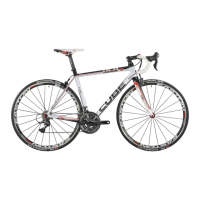MTB/ ROAD BIKE/ TREKKING
7.8.3 Check hydraulic rim brakes
1. Check correct xing and screw connec-
tions of the entire brake system:
•
Try to pull the brakes out of the sockets by
hand.
•
It should not be possible to loosen the
brakes from the sockets by hand.
A small amount of play is normal.
2. Check your brake system seals:
•
Operate each brake lever in a static position
and hold the brake lever in that position.
•
Check the brake system from the brake lever
along the lines to the brakes.
•
There must be no egress of hydraulic uid at
any point
3. Check operation of the brake shoes:
•
With the brake applied the brake shoes must
be in contact with the rim shoulder along
their entire length.
•
The brake shoe must never touch the tyre –
even if the brake is not applied.
7.8.4 Check hydraulic disk brakes
Risk of Personal Injury and Material
Damage!
Dirty brake disks may reduce braking
eciency.
•
Dirty brake disks may reduce braking
eciency.
1. Pull the brake calliper alternately in all
directions.
•
It should not be possible to move the
caliper.
2. Check your brake system seals:
4. Check the brake block wear.
•
The brake blocks must not be worn down
beyond the wear indicator.
•
Operate each brake lever in a static position
and hold it,
•
Check the brake system from the brake lever
along the lines to the brakes.
•
There must be no egress of hydraulic uid at
any point.
3. Check brake disk for damage:
•
There must be no grooves, ruptures, deep
scratches or other mechanical damage.
4. Lift the front or rear road wheel and turn
it by hand:
•
The brake disk must only have a slight axial
run-out.

